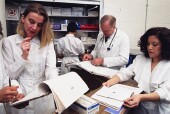 |
 |
 |

Certified ER Docs in Short Supply to Meet Future Needs
Even in best-case scenario, study says more than a decade needed to achieve goals|
|
HealthDay
By Robert Preidt
Friday, January 9, 2009
 FRIDAY, Jan. 9 (HealthDay News) -- The number of board-certified emergency doctors in the United States will likely fall short of hospital emergency department staffing needs in the future, say Massachusetts General Hospital (MGH) researchers.
FRIDAY, Jan. 9 (HealthDay News) -- The number of board-certified emergency doctors in the United States will likely fall short of hospital emergency department staffing needs in the future, say Massachusetts General Hospital (MGH) researchers.
The scientists suggested that alternative strategies for staffing emergency departments are needed.
"Thousands of emergency departments are not currently staffed by physicians with this type of training," study leader Dr. Carlos Camargo, of the department of emergency medicine, said in an MGH news release. "We questioned whether staffing every department with residency-trained, board-certified emergency physicians -- which some individuals have advocated for decades -- was a realistic goal. So, we set out to estimate emergency physician workforce needs, taking into account the diversity of hospitals across the country and projections about the future physician supply."
The researchers' analysis of data from the 2005 National Emergency Department Inventories USA database found there were 22,000 board-certified emergency physicians already in practice and 1,350 who were newly certified that year.
Having at least one board-certified emergency doctor present in all U.S. hospital emergency departments at all times would require 40,000 physicians with such training, which means that only 55 percent of demand was being met in 2005.
Camargo and colleagues developed a number of scenarios for future emergency physician supply: an intentionally unrealistic best-case scenario in which no board-certified emergency doctor ever died or retired; a worst-case scenario that assumed an annual 12 percent loss of board-certified emergency doctors; and an intermediate scenario that assumed a 2.5 percent loss per year.
Under the intermediate scenario, it would take until 2038 to meet the goal of at least one board-certified emergency doctor present in all U.S. hospital emergency departments at all times. Under the worst-case scenario the goal would never be met. Even under the best-case scenario, it would take more than a decade to achieve the goal.
"The mismatch between the supply and demand ... is a longstanding problem," said Camargo, an associate professor of emergency medicine at Harvard Medical School. "The need for emergency services is large and growing; and even if existing programs graduated more physicians, there is little reason to think more of those graduates would move to the rural areas that are particularly short on physicians with this specialized training."
Camargo said alternatives should be examined, "such as giving the family physicians who currently staff many U.S. emergency departments extra training in key emergency procedures. We might also increase our reliance on nurse practitioners and physicians assistants, who can help emergency physicians of any training background better handle the continually rising number of patients."
The study was published in the December issue of Academic Emergency Medicine.
HealthDay
Copyright (c) 2009ScoutNews, LLC. All rights reserved.
Related News:
More News on this Date
Related MedlinePlus Pages:
| Home | Health Topics | Drugs & Supplements | Encyclopedia | Dictionary | News | Directories | Other Resources | |
| Disclaimers | Copyright | Privacy | Accessibility | Quality Guidelines U.S. National Library of Medicine, 8600 Rockville Pike, Bethesda, MD 20894 National Institutes of Health | Department of Health & Human Services |
Date last updated: 12 January 2009 |




